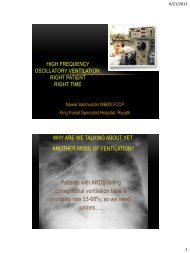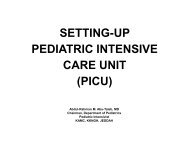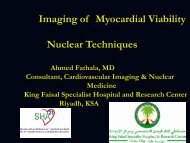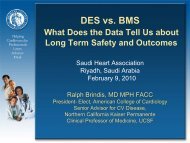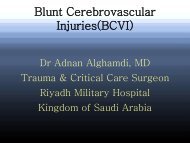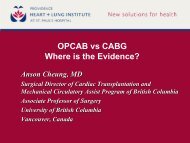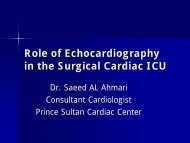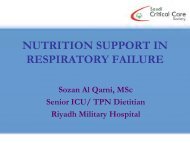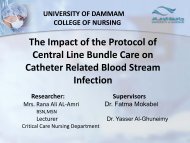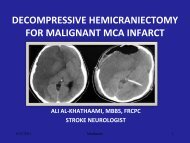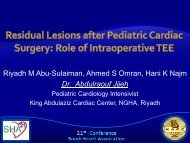Surfactant replacement therapy in acute respiratory ... - RM Solutions
Surfactant replacement therapy in acute respiratory ... - RM Solutions
Surfactant replacement therapy in acute respiratory ... - RM Solutions
- No tags were found...
You also want an ePaper? Increase the reach of your titles
YUMPU automatically turns print PDFs into web optimized ePapers that Google loves.
<strong>Surfactant</strong> Replacement Therapy<strong>in</strong> Children with Acute RespiratoryDistress SyndromeDr Ali Al shehriPediatrics Critical care consultantAssistant professor pediatricsK<strong>in</strong>g Saud B<strong>in</strong> Abdulaziz for health sciencesKAMC/KFNGH
Disclosure
Case 1• 2 yrs boy 50% flam burn , <strong>in</strong>halation<strong>in</strong>jury• COHb : 14 % on 100% FiO2 .• Hypoxic <strong>in</strong>dex: 568 .• ABC• Day 2 : OI : 53 PaO2/FiO2: 71• HFOV: MAP: 38 AMP: 80Hz : 7 FiO2 100% Sat : 85%• Permissive hypercapnea
Case 1• Dopam<strong>in</strong>e : 10 micg/kg/m<strong>in</strong>t.• UO : normal• <strong>Surfactant</strong> (servant) given 80 ml/m2/dose.• Improve oxygenation.• Day3 : OI: 20.• Multiple debridement and graft<strong>in</strong>g.• Extubated week 5.• Discharge week 6.
Case 2• Preterm 24/52, CA 10 days, BPD referred forlaser photocoagulation.• Day 2 : RSV bronchiolitis.• Intubated : HFOV, OI :51, HI: 56• Dopam<strong>in</strong>e : 15 micg/kg/m<strong>in</strong>t• <strong>Surfactant</strong> (servant) 4ml/kg , two doses given.• Day 4 : shift to CMV.• OI : 10• Extubated : 18 days .• Discharge : one month.
Cl<strong>in</strong>ical Trials <strong>in</strong> Neonate• 2000-2005.• Birth –one month.• Children excluded .• 175 paper, 43 RCTs or SR.- Reduce mortality and pulmonary air leak- Severe meconium aspiration syndrome: reduce MV, O2 <strong>therapy</strong> ,time for hospitalization and need for ECMO.Halliday HL. Recent cl<strong>in</strong>ical trials of surfactanttreatment for neonates. Biol Neonate 2006; 89:323–329
<strong>Surfactant</strong>• Type II pneumocytes.• Lower alveolar surface tension.• 80% phospholipids (dipalmitoyl phosphatidylchol<strong>in</strong>e 85% ).• 8% neutral lipids.• 12% prote<strong>in</strong>s SP –A,B,C, and D- Surface tension (A,B,C )- Immune defense , particle clearance- Modulate lung <strong>in</strong>flammation ( D , A )
Type of <strong>Surfactant</strong>Ped criti care medic<strong>in</strong>e basic science and cl<strong>in</strong>ical evidence Derrk 2007
Type of <strong>Surfactant</strong>PhLip SPA SPB SPC SPDHumann surfactant 85% 5% 2% 2% 1%Exogenous naturel <strong>Surfactant</strong> 96% 0 2% 2% 0Infarsurf (Calfctant ) 0.9%Survanta (Beractant) 0.004%Synthetics <strong>Surfactant</strong> 100% 0 0 0 0Exosurf
Cl<strong>in</strong>ical trails• Outcome related :- Mode of delivery/dose(Better with entubation)- Direct vs <strong>in</strong>direct ALI(Better <strong>in</strong> direct )- Type of surfctant .-Time .(Natural better and moreresistant for <strong>in</strong>hibitionthan synthetics )(Early better than late )
Cl<strong>in</strong>ical trial adult• 4 RCT• Failed to demonstrate a mortality benefit.- Anzueto A, et al. Aerosolized surfactant <strong>in</strong> adults with sepsis-<strong>in</strong>duced <strong>acute</strong> <strong>respiratory</strong>distress syndrome: Exosurf Acute Respiratory Distress Syndrome Sepsis Study Group.N Engl J Med 1996; 334:1417–1421- Gregory TJ, Ste<strong>in</strong>berg KP, Spragg R, et al. Bov<strong>in</strong>e surfactant <strong>therapy</strong> for patients with<strong>acute</strong> <strong>respiratory</strong> distress syndrome. Am J Respir Crit Care Med 1997; 155:1309–1315- Lewis JF, Walmrath HD, et al. Effect of recomb<strong>in</strong>ant surfactant prote<strong>in</strong> C-basedsurfactant on the <strong>acute</strong> <strong>respiratory</strong> distress syndrome. N Engl J Med 2004; 351:884–892- Jozef Kesecioglu1 et al, Exogenous Natural <strong>Surfactant</strong> for Treatment of Acute LungInjury and the Acute Respiratory Distress Syndrome Am J Respir Crit Care Med Vol180. pp 989–994, 2009-
Cl<strong>in</strong>ical trial <strong>in</strong> pediatrics• RCT6 ( 3 ALI/ARDS an 3 bronchiolitis)• Case report 20• Uncontrolled 7• Retrospective 3• Case control 1• Non randomized 1Duffett M, Choong K, Ng V, RandolphA,Cook DJ: <strong>Surfactant</strong> <strong>therapy</strong> for <strong>acute</strong><strong>respiratory</strong> failure <strong>in</strong> children: asystematic review and meta-analysis.Crit Care 2007.
Cl<strong>in</strong>ical trial <strong>in</strong> pediatrics ALI/ARDS• Improve gas exchange, reduce PIP and shorten CPPV and ICU stayLuchetti et al, Porc<strong>in</strong>e-derived surfactanttreatment of severe bronchiolitis Scaactaaneasthesiol 1998 Aug;42(7):805-10.• Reduce PIP, , MV days p
Cl<strong>in</strong>ical trial <strong>in</strong> pediatrics ALI/ARDS• Douglas F. Willson et al. JAMA, January 26, 2005—Vol 293.- Improve oxygenation and mortality.- M<strong>in</strong>or transient hypoxia , hypotension around <strong>in</strong>stillation
Cl<strong>in</strong>ical trial <strong>in</strong> pediatrics• Phase 3 multicenteral trail, randomized, bl<strong>in</strong>ded• Natural lung surfactant (calfactant) vs placebo .• 21 centers.• 153 patient.• 3 years study period.Wilson etal jama 293: 470-476, 2005
Cl<strong>in</strong>ical trial <strong>in</strong> pediatrics• Eligibility- Age 1 wk to 21 yrs.- Respiratory failure due to parynchymal lung disease .• Enrollment with<strong>in</strong> 24 hours of <strong>in</strong>itiation of mechanicalventilation( extended to 48 hours after the first 50 patient) .• OI > 7Wilson etal jama 293: 470-476, 2005
Cl<strong>in</strong>ical trial <strong>in</strong> pediatrics• Treatment regimen : 80 ml/m2 /dose calfcatant over 10 -15m<strong>in</strong>t.• Retreatment ( 2 nd dose )At 12 hours if OI >7Wilson etal jama 293: 470-476, 2005
Cl<strong>in</strong>ical trial <strong>in</strong> pediatricsWilson etal jama 293: 470-476, 2005
Cl<strong>in</strong>ical trial <strong>in</strong> pediatrics• Subgroup analysis :- MR higher OI >13(37%) compared with OI >7 < 13(20%)- Less mortality <strong>in</strong> direct vs <strong>in</strong>direct lung <strong>in</strong>jury placebo(8% vs 37%; P=.007)Wilson etal jama 293: 470-476, 2005
MortalityDuffett M, choong k etal meta-analysis. CritCare 2007.
Ventilator-free daysDuffett M, choong k etal meta-analysis. CritCare 2007
Duration of Mechanical ventilationDuffett M, choong k etal meta-analysis. CritCare 2007
Duration PCCU stayDuffett M, choong k etal meta-analysis. Crit Care2007
Cl<strong>in</strong>ical trial <strong>in</strong> pediatrics• RCT 1997 - 1999. pilot• PaO2/FIO2 < 100.• Result:- Improve oxygenation at 48 hrs dose (p 65• Patients with
Cl<strong>in</strong>ical trial <strong>in</strong> pediatricsInitial severity of hypoxemia correlated with mortalityPediatric Acute Lung InjuryProspective Evaluation of Risk Factors Associated withMortality Heidi R. Flori, Am J Respir Crit Care MedVol 171. pp 995–1001, 2005
Summery• ARDS/ ALI is life threaten<strong>in</strong>g disease .• <strong>Surfactant</strong> adm<strong>in</strong>istration carry m<strong>in</strong>imal adverse effectswith potential benefit .• RCT could NOT prove the efficacy.• Many confounders affect<strong>in</strong>g the result of RCT.• Outcome surrogate variable other than mortality .
Summery• <strong>Surfactant</strong> not recommended as rout<strong>in</strong>e <strong>therapy</strong> .• May used <strong>in</strong> comb<strong>in</strong>ation with other adjunct : if Protectivelung strategies and permissive hypercapnea optimized , maxand no benefit .• Consider <strong>in</strong> pt with potential max benefit with younger age ,high hypoxic <strong>in</strong>dex , direct lung <strong>in</strong>jury, immunocompetent.• Further study .
Thank you



